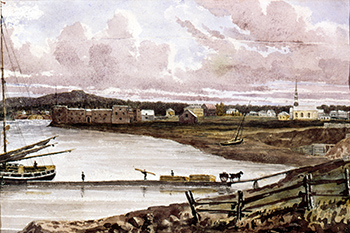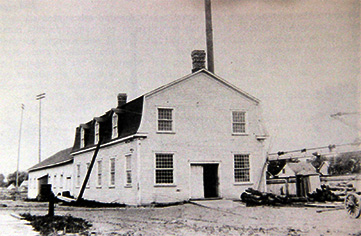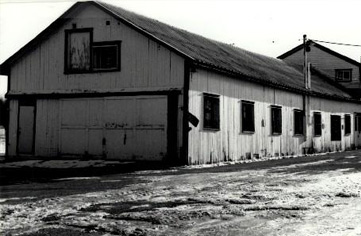
The Chambly canal workshops in 1894. You can see (from left to right): the carpentry shop and its different sections, the 1890 forge (brick building) and the wood shed. Photo: Library and Archives Canada (LAC) / PA-85628.
The Chambly Canal Workshops
Chambly Canal National Historic Site
The workshops have always been linked to the smooth operation of the canal; they are essential to the waterway’s operations. It is here that Parks Canada performs various maintenance and repair work. When a breakdown occurs, the proximity of the canal and the workshops means less downtime for navigation. In the past, carpentry and joinery work required for maintaining and repairing lock gates, lock components and bridges was done here. Today, Parks Canada carpenters, welders, electricians and other technicians prepare a multitude of materials used in Quebec’s five historic canals.
The canal

Built in two phases, from 1831 to 1835 and from 1840 to 1842, the Chambly Canal was officially opened to commercial navigation on June 9, 1843. In the canal era of the 19th century, the Richelieu River, through the Chambly Canal, became one of the key components of a vast network of waterways in the American Northeast, facilitating the transit of numerous goods from the North to the South. Although pleasure boating has replaced commercial navigation for almost 50 years, the original function of the Chambly Canal remains: to be an operational waterway. Learn more about the construction of the Chambly Canal
The workshops: toward a new location along the waterway

In order to allow for the continued operation of this vital waterway for trade, it was necessary to build maintenance and repair shops nearby. And so, the first workshop was designed to meet these needs only a few months after the official opening of the Chambly Canal in 1843. This first “workshop” was located in the area adjacent to the combined locks 1, 2 and 3, near the Chambly basin.
But after more than three decades of operation, the structures and buildings of the Chambly Canal themselves needed repair and maintenance. Thus, in 1883, maintenance and repair operations were transferred to the present site occupied by the Chambly Canal workshops, located between locks 3 and 4. Naturally, the new site, its dimensions and its buildings would evolve during the first years and over time.
The workshops: setting up a new complex

A large part of a new carpentry workshop, still present today and recognizable by its mansard roof, was built around 1883. Subsequently, six sections were added to the building to accommodate the needs of the various eras until the early 1960s. The different sections of the building now include about ten rooms used as a variety of workshops. Despite the numerous transformations made to the internal partitions of the multiple sections, this building still retains its role as a workshop for the Chambly Canal.
Also in 1886, the workshop building in the area of the combined locks was moved to the new location. Converted into a blacksmith shop in 1888, the building was destroyed by fire in January 1890. As a result, a “modern” - for the end of the 19th century - and functional forge was built and inaugurated in March 1890. Around the same time, a lumber warehouse was added to the workshop landscape. These buildings bear witness to the work of the first permanent employees of the Chambly Canal, employees who carried out the carpentry, joinery and blacksmithing work required to maintain and repair the waterway’s equipment.
In the the the early 20th century, a storage shed (1911-1912) for canal equipment such as cranes, road rollers and large structural components, a horticultural materials warehouse (1934) and a shed were added to the existing buildings.
The workshops: the site today
The landscape of the workshop complex has changed significantly since the late 1960s. Buildings such as the forge and the lumber warehouse have been replaced by the “new workshop,” built in the early 1970s. Functional in design, it incorporates the modern construction techniques and materials of the last 50 years.
Thus, the presence of different generations of buildings, activities and works that may have taken place there, all confirmed by historical and photographic documentation, suggests the presence of numerous archaeological remains of constructions and equipment related to maintenance operations on the site over the years. Although the area of the canal workshops has changed over time (some buildings have disappeared, others have been built, some have been modified), the complex still retains its role as a workshop and maintenance facility for the Chambly Canal waterway operations and has done so for over 135 years.

- Date modified :